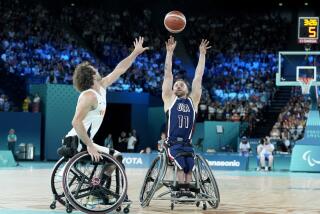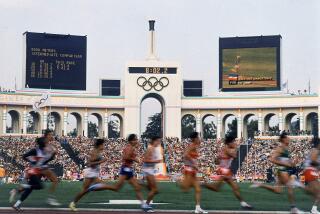Wheelchair Racers Set Pace for Disabled
It was a cloudless morning and people whose horizons once seemed a dark gray sat in their ultralight, aerodynamic wheelchairs in front of the Long Beach Convention Center and prepared to race.
An able-bodied woman, dressed in runner’s clothing, said, “It amazes me watching these people. I’m mesmerized.”
Jim Knaub of Long Beach, a world-class wheelchair racer and an actor, was there. But he wasn’t racing, although when the wheels started turning he looked as if he wished he were. He said he is retired.
“I’ve been racing six years,” said Knaub, who twice won the Boston Marathon and holds most of wheelchair racing’s records. “I’ve done all there is to do.”
But he is still heavily involved in the sport, working for Invacare Corp. as a specialist in the development of high-performance wheelchairs.
A handsome man of 29, Knaub wore a blue windbreaker and sunglasses and was in his van, ready to lead the racers along the 13-mile course in the wheelchair division of last Sunday’s Long Beach Half-Marathon. He was the event’s honorary chairman.
The race started and, with the Long Beach shoreline as the backdrop, George Murray of St. Petersburg, Fla., moved quickly to the lead.
“Does that exhaust bother you?” Knaub called back to Murray, who was furiously “hammering” (turning) his wheels.
Murray said it was no problem.
Near the Queen Mary, a taxi pulled between Murray and the van.
“This is beautiful,” Knaub said sarcastically as he looked in his rear-view mirror.
The cabbie kept going.
“You fool! You fool!” Knaub hollered. “Get out of the way.”
A policeman on a motorcycle accompanying Knaub said, “What a dumb bastard.”
“That’s why I’m not racing, pal,” said Knaub.
Knaub is a fierce defender of wheelchair racers, especially those who were athletes before they were crippled, and bristles at suggestions they are inferior to runners.
“When we first started competing, runners would look at us and say, ‘Isn’t that incredible?’ ” Knaub said. That was a decade ago.
“Then our times improved and we started racing them for first place. Things got a little nasty. They said, ‘It’s not fair, you have a mechanical advantage.’ ”
Knaub said most runners are nicer now. Along the course Sunday, the runners applauded the wheelchair racers.
“But there are still pockets of athletes (runners) who don’t feel we’re at the same level as they are,” Knaub said.
“One said to me, ‘You’re not an athlete, what have you done?’ And I said to him, ‘Who the hell are you?’ He was nothing. I am an athlete who happens to be in a wheelchair.”
Knaub was a state champion pole vaulter at Lakewood High School in 1974 and a Pacific Coast Athletic Assn. champion at California State University, Long Beach. He cleared 17 feet, 2 inches in 1976 and was an Olympic trials finalist. His whole life, which had been aimed at the Olympics, was on course.
Then in 1978, a car crashed head-on into his motorcycle in La Mirada, smashing his dreams and a good part of his body. He is paralyzed from the waist down. “And from the neck up,” he likes to joke.
Knaub recalled the first months after the accident. “Part of me was frustrated. I had been jumping real well. I said, ‘Why me?’ But a deeper part of me said, ‘This is where I’m supposed to be.’ We all have our role to play. I’m enjoying myself, although I wouldn’t recommend a wheelchair for anybody.”
Murray was on Ocean Boulevard in Belmont Shore now and cruising along, all alone in front. He would hammer for six seconds, then coasts for five.
“Yeah, all right!” cheered a spectator.
Knaub and Murray, now probably the sport’s king, were longtime competitors.
“I beat him often enough to be satisfied,” Knaub said.
A man on a bike called to Knaub, who was checking out a female jogger.
“What’s going on?” the man asked, his bike easing inside the orange cones that marked the course, irritating Knaub.
“We’re having a cone-setting-up championship,” Knaub said.
Murray was soon coming back on Ocean, far ahead of the other wheelchair racers and the runners, who were going by in the opposite direction.
One was a kid who was hammering the best he could.
“Good job, Jody, just hang in there,” shouted Knaub, sticking his head out of the window.
The youth was Jody Kemp, 14, of Jackson, N.J., who is just starting out in a sport that Knaub had inspired him to take up this year. This was his third road race.
“This is the highlight of his life,” Knaub said. “He looks at people in this sport as role models.”
The race was turning off onto Shoreline Drive for the home stretch.
Two girls on bicycles rode in front of Murray, almost brushing him, which made Knaub incredulous. “People are unconscious, unconscious,” he said. “And the cops are standing there looking for coffee and doughnuts.”
Murray, 38, who has broken the four-minute mile in a wheelchair, took the race easily in 56 minutes and won $900. He looked at a gadget on his chair that told him he had averaged 14.2 m.p.h. with a top speed of 25.9.
Like most of the men in this sport, his arms were huge, with veins visible along the biceps. His legs, though, like the others who have legs, were thin and tucked in.
Murray said Knaub’s absence “makes it an empty challenge. Jim and I, in terms of speed, could challenge each other.” He said there are only a handful of wheelchair racers in the world in their class.
Near the finish line at Shoreline Village, there was the smell of oranges, which were being sucked by the athletes. Knaub looked around and saw Bob Hall, whom he calls the father of wheelchair racing and who had come from Boston to race. This was the man who had been Knaub’s inspiration.
While in the hospital, Knaub saw Hall win the Boston Marathon on TV.
“When I saw Bobby Hall go up the hill in Boston in the rain, I said, ‘That’s what I want to do,’ ” Knaub said.
Before that Knaub had the usual image of wheelchair sports: “Guys with big arms who played basketball.”
Hall, 34, a polio victim, became the first wheelchair athlete to compete in the Boston Marathon, finishing it in 1975 in a conventional, cumbersome 50-pound wheelchair in almost three hours.
Knaub, in a race chair 35 pounds lighter, won at Boston in 1983 with a record time of 1:47.10.
“He helped make changes in the sport and changed people’s attitudes about us,” Hall said of Knaub. “He’s not afraid to speak his mind.”
Knaub is not always brash and sarcastic.
“Jim is very kind-hearted.” Hall said. “He’d give you the shirt off his back.”
Hall remembered that he felt like an oddity when he first started racing. “It was like the whole world was watching,” he said. “But I thought my goal was more important than people’s attitudes. When I succeeded (in 1975 at Boston), it was as if we all succeeded.”
The oldest participant in Long Beach was Max Rhodes, 72, of Miami.
“Jim brought me here,” said Rhodes, who has been a wheelchair racer for 1 1/2 years.
Rhodes fell off a ladder 16 years ago and is paralyzed from his waist to his knees. “After that I never got around to doing nothing,” he said. “Now I feel better. I haven’t been admitted to the hospital in almost a year. I did a 50-mile race in Florida last summer and won it.”
Jody Kemp finally finished an hour and 47 minutes after he started. Jody, who was hit by a car while riding his bike to school in September, 1984, is paralyzed from the chest down.
“When I was in the hospital I kind of figured it out that I wasn’t going to walk anymore,” he said. “I saw a picture of a bunch of wheelchair racers and that turned it around for me.”
That and meeting Knaub and watching him compete in a wheelchair race in Edison, N.J.
“When I saw that I was sure I had to do it,” said Jody, who said he wasn’t much of an athlete before his accident.
Now he is the future of the sport, as Knaub once was.
“He’s really nice,” Jody said of Knaub. “It freaked me out when he invited me here. He’s my idol, I want to be like him.”
Jody looked out over the water and the boat and smelled the oranges.
“I love it here, it’s so beautiful,” he said.
There still wasn’t a cloud in sight.
More to Read
Sign up for Essential California
The most important California stories and recommendations in your inbox every morning.
You may occasionally receive promotional content from the Los Angeles Times.










